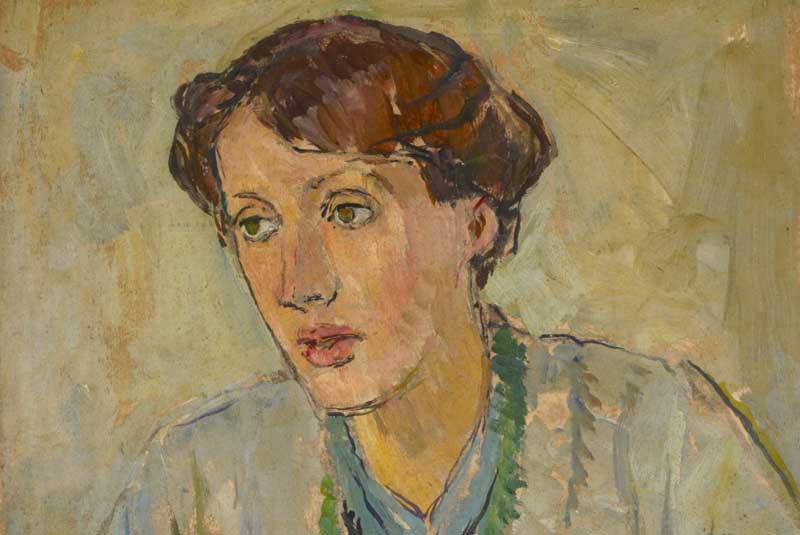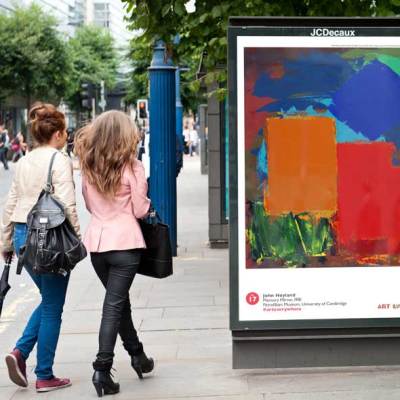‘The Grafton, thank God, is over’ wrote Virginia Woolf after Roger Fry’s second exhibition of post-Impressionist paintings at the Grafton Galleries in 1912, ‘artists are an abominable race. The furious excitement of these people all winter over their pieces of canvas, coloured green and blue, is odious.’ Woolf always had, or pretended to have, a conflicted relationship with the visual arts. Though she admired the work of and ideas of Fry and Clive Bell, it was an admiration often tempered by impatience. In her writing she was interested in the insides rather than the exteriors of her subjects – the inner life of ‘Mrs Brown’, the subject of one of her most famous essays, could never be captured in paint. Though she said that ‘writing and painting’ had ‘much to tell each other’, she also conceded that they ‘must part in the end.’
Virginia and Leonard Woolf (1939), Gisele Freund © Estate Gisele Freund / IMEC Images

The conflict between writing and painting, and the way this conflict informed Woolf’s own writing, is played out in fascinating detail at ‘Virginia Woolf: Art, Life and Vision’, (at the National Portrait Gallery until 26 October), expertly curated by Frances Spalding. Woolf herself emerges as the still centre of the aesthetic and literary activities of the Bloomsbury group: a sober foil to Roger Fry’s more hysterical takes on ‘significant form’ and the lessons of Post-Impressionism. But she also emerges as a defender of aesthetic experiment: it was the ability of art not just to represent but to change life that Woolf believed in most of all. ‘On or about December 1910’, she famously declared of Fry’s Grafton exhibition in a more tolerant mood, ‘human character changed.’
Many of the techniques championed by Fry and Bell found their analogues in Woolf’s literary techniques. Their rejection of Victorian narrativity and sentimentality in painting in favour of a formal coherence is echoed in Woolf’s short fictions, which often aspire to the condition of painting. Lusters, marks on walls, snail shells: in Woolf’s writing solid objects are deconstructed and alienated, made strange and new. But literature had much to teach painting too, Woolf suggested. Of her sister Vanessa Bell’s A Conversation (1913–16) she wrote ‘I think you are a most remarkable painter. But I maintain you are into the bargain, a satirist, a conveyor of impressions about human life: a short story writer of great wit and able to bring off a situation in a way that rouses my envy. I wonder if I could write the Three Women in prose.’
Virginia Woolf (c. 1912), Vanessa Bell © Estate of Vanessa Bell, courtesy Henrietta Garnett. Photo © National Trust / Charles Thomas

What emerges most strongly at the National Portrait Gallery is the degree to which what Woolf called the ‘Sister’s arts’ of writing and painting fed off one another. The portraits of Woolf by her sister are some of the most interesting paintings on display, but the archival material is fascinating too: first editions of Woolf’s novels (with woodcuts by Vanessa Bell), of Ulysses and the Hogarth-published ‘The Waste Land’; letters from Virginia and Leonard Woolf to their friends, and Gisele Freund’s wonderful, haunting colour photographs of Woolf. One terrifying artefact is the Black Book, a list of persons to be arrested and imprisoned by the Nazis in the event of an invasion of Britain. The Woolfs are both listed.
The whole thing has the effect of eavesdropping on one of Bloomsbury’s rather self-conscious ‘conversaziones’. It is thrilling, domestic, intimate and beguiling: a wonderful exhibition.
‘Virginia Woolf: Art, Life and Vision’ is at the National Portrait Gallery, London, until 26 October.



